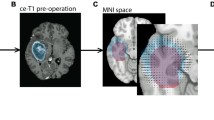Abstract
Objective
To introduce a novel approach for the monitoring of glioma evolution by the extraction of mathematical parameters from follow-up MRI.
Material and methods
The method consists of the registration of follow-up MR images and the analysis of the deformation field. The registration was performed through an affine transformation followed by a non-rigid registration using free-form deformations (FFDs). A subsequent analysis of the transformation non-linear component is then performed by using the jacobian operator in order to extract information related to tumor evolution. In order to test the algorithm’s performance two different validations were performed: (a) a numerical validation utilizing both physical and digital phantoms, (b) a clinical validation using neurosurgeon clinical judgements.
Results
Quantitative validation showed that the jacobian describes the volumetric variations of the physical phantom with an error of 5%. Furthermore, simulations with a digital phantom provided an estimation of the error introduced by registration (6.4%). Clinical validation provided good clinical scores: the score evaluating the correspondence between extracted variables and patient evolution was 4.37 ± 0.89 for the deformation field and 4.43 ± 0.82 for the jacobian image (top score: 5).
Conclusion
The novel approach leads to an objective and quantitative description of tumor evolution. Therefore, it could be valuable for planning interventions and/or treatments.
Similar content being viewed by others
References
Quigley MR, Post C, Ehrlich G (2007) Some speculation on the origin of glioblastoma. Neurosurg Rev 30(1): 16–20
Debnam JM, Ketonen L, Hamberg LM, Hunter GJ (2007) Current techniques used for the radiologic assessment of intracranial neoplasms. Arch Pathol Lab Med 131(2): 252–260
Henson JW, Gaviani P, Gonzalez RG (2005) MRI in treatment of adult gliomas. Lancet Oncol 6(3): 167–175
Patriarche J, Erickson B (2004) A Review of the Automated Detection of Change in Serial Imaging Studies of the Brain. J Digit Imaging 17: 158–174
Padhani AR, Ollivier L (2001) The RECIST (response evaluation criteria in solid tumors) criteria: implications for diagnostic radiologists. Br J Radiol 74: 983–986
Clark MC, Hall LO, Goldgof DB, Velthuizen R, Murtagh FR, Silbiger MS (1998) Automatic tumor segmentation using knowledge-based techniques. IEEE Trans Medical Imaging 17(2): 187–201
Clarke LP, Velthuizen RP, Camacho MA et al (1995) MRI Segmentation: methods and applications. Magn Reson Imaging 13: 343–362
Clarke LP, Velthuizen RP, Clark M et al (1998) MRI Measurement of brain tumor response: comparison of visual metric and automatic segmentation. Magn Reson Imaging 16: 271–279
Ho S, Bullitt E, Gerig G (2002) Level set evolution with region competition: automatic 3-D segmentation of brain tumors. In: Proceedings of 16th International Conference on Pattern Recognition. IEEE Computer Society, Washington, pp 532–535
Liu J, Udupa JK, Hackney DC, Moonis G (2001) Estimation of tumor volume with fuzzy connectedness segmentation of MRI. Proc SPIE Med Imag 4322: 1455–1465
Clatz O et al (2005) Realistic simulation of the 3D growth of brain tumors in MR images coupling diffusion with mass effect. IEEE Trans Medical Imaging 24(10): 1334–1346
Kyriacou S et al (1999) Nonlinear elastic registration of brain images with tumor pathology using a biomechanical model. IEEE Trans Medical Imaging 18(7): 580–592
Rey D, Subsol G, Delingette H, Ayache N (2002) Automatic detection and segmentation of evolving processes in 3D medical images: application to multiple sclerosis. Medical Image Anal 6(2): 163–179
Denton ERE, Sonoda LI, Rueckert D, Rankin SC, Hayes C, Leach M, Hill DLG, Hawkes DJ (1999) Comparison and evaluation of rigid and non-rigid registration of breast MR images. J Comput Assist Tomogr 23: 800–805
Rueckert D, Sonoda LI, Hayes C, Hill DLG, Leach MO, Hawkes DJ (1999) Non-rigid registration using free-form deformations: application to breast MR images. IEEE Trans Medical Imaging 18(8): 712–721
Schnabel J, Rueckert D, Quist M, Blackall JM, Castellano Smith AD, Hartkens T, Penney GP, Hall WA, Liu H, Truwit CL, Gerritsen FA Hill DLG, Hawkes DJ (2001) A generic framework for non-rigid registration based on non-uniform multi-level free-form deformations. In: Fourth Int Conf on Medical Image Computing and Computer-Assisted Intervention (MICCAI ’01), pp 573–581, Utrecht, NL
Maes F, Vandermeulen D, Suetens P (2003) Medical image registration using mutual information. Proc IEEE 91(10): 1699–1722
Pluim JP, Maintz JB, Viergever MA (2003) Mutual-information-based registration of medical images: a survey. IEEE Trans Med Imaging 22: 986–1004
Viola P (1995) Alignment by maximization of mutual information. Ph.D. thesis, Massachusetts Institute of Technology
Davatzikos C, Vaillant M, Resnick S, Prince JL, Letovsky S, Bryan RN (1996) Morphological analysis of brain structures using spatial normalization. Vis Biomed Comput Lect Notes Comput Sci 1131: 355–360
Author information
Authors and Affiliations
Corresponding author
Rights and permissions
About this article
Cite this article
Iacono, M.I., Passera, K., Magrassi, L. et al. A method to analyze the evolution of malignant gliomas using MRI. Int J CARS 3, 571–579 (2008). https://doi.org/10.1007/s11548-008-0263-0
Received:
Accepted:
Published:
Issue Date:
DOI: https://doi.org/10.1007/s11548-008-0263-0




